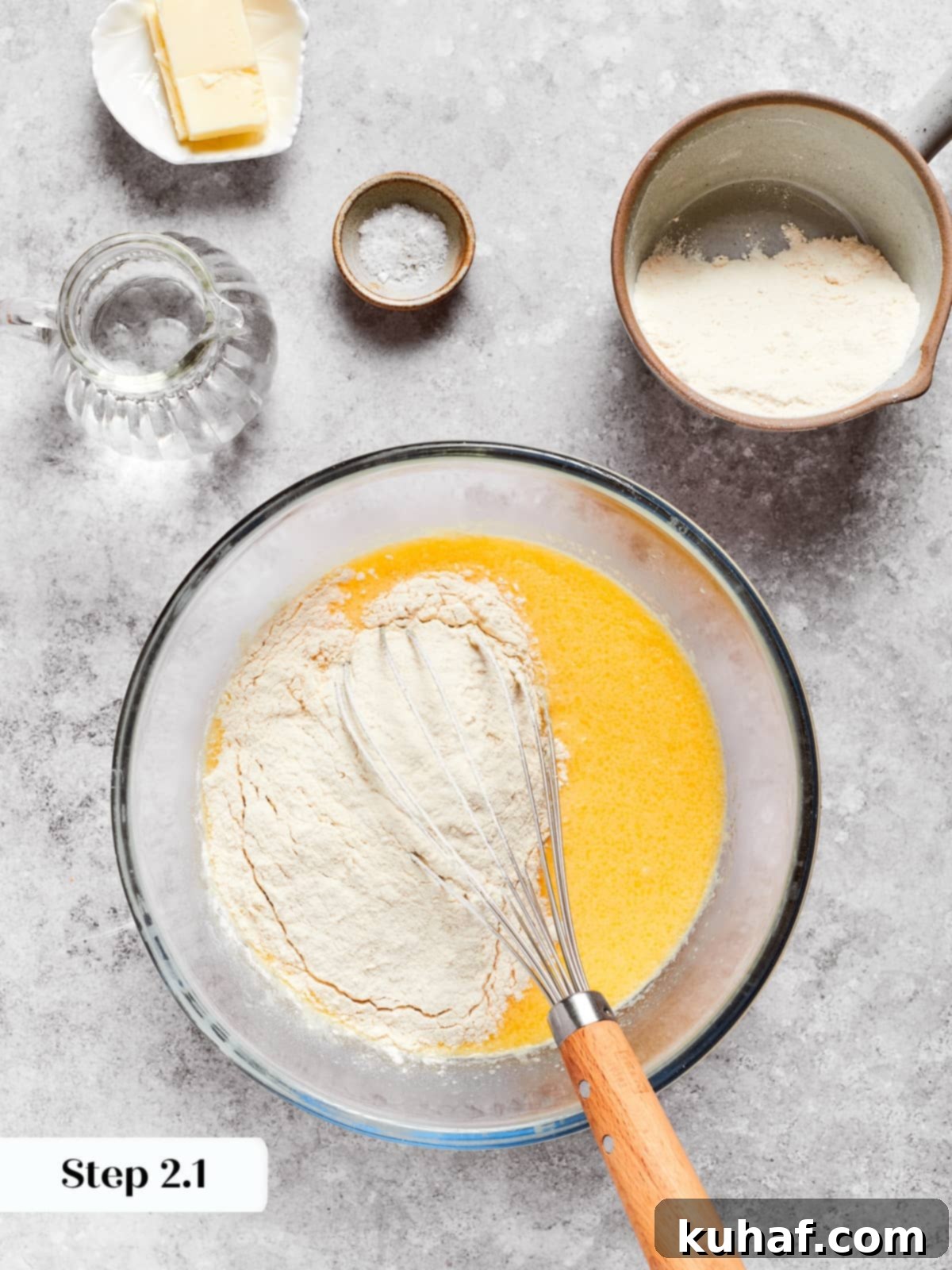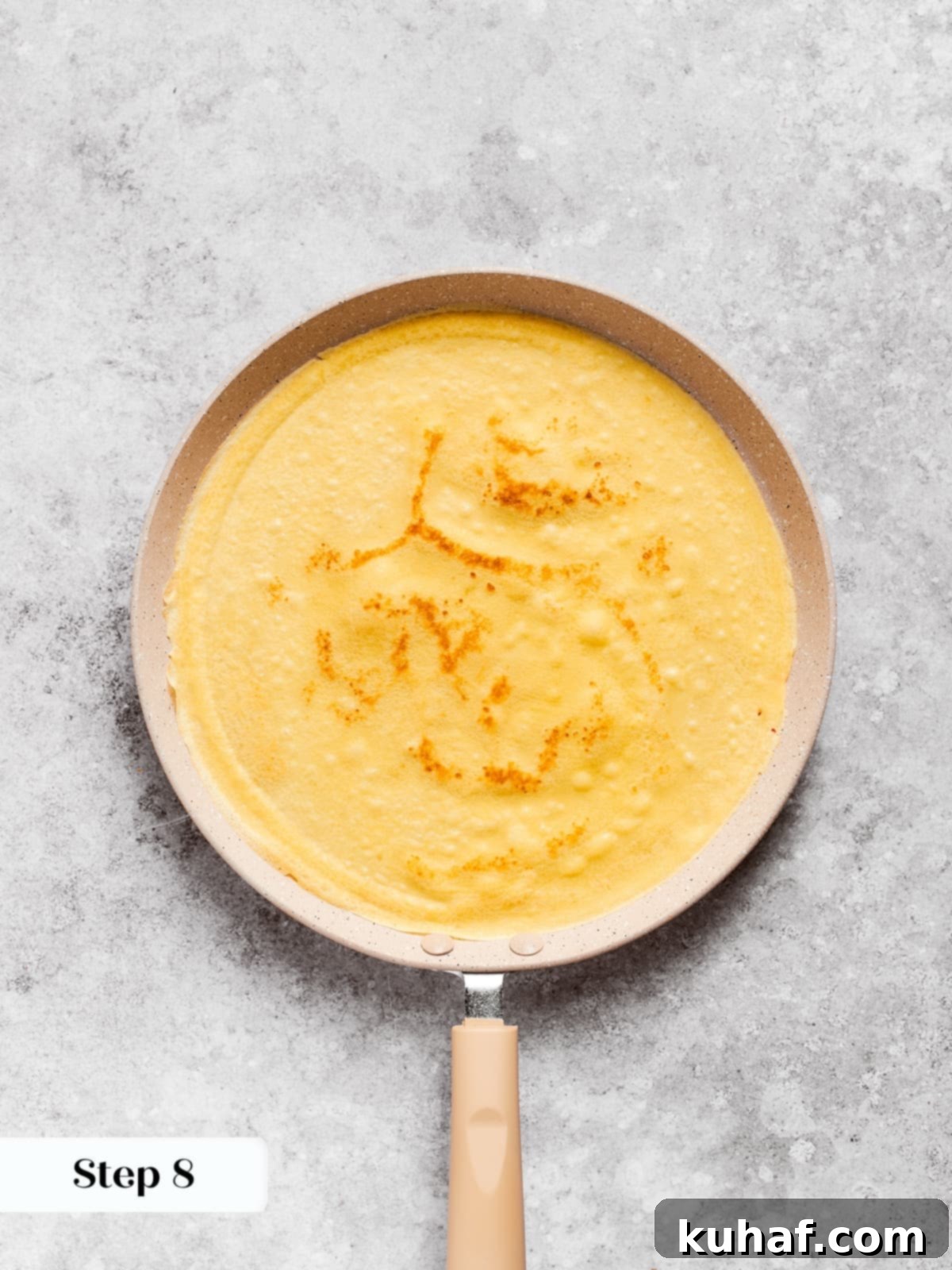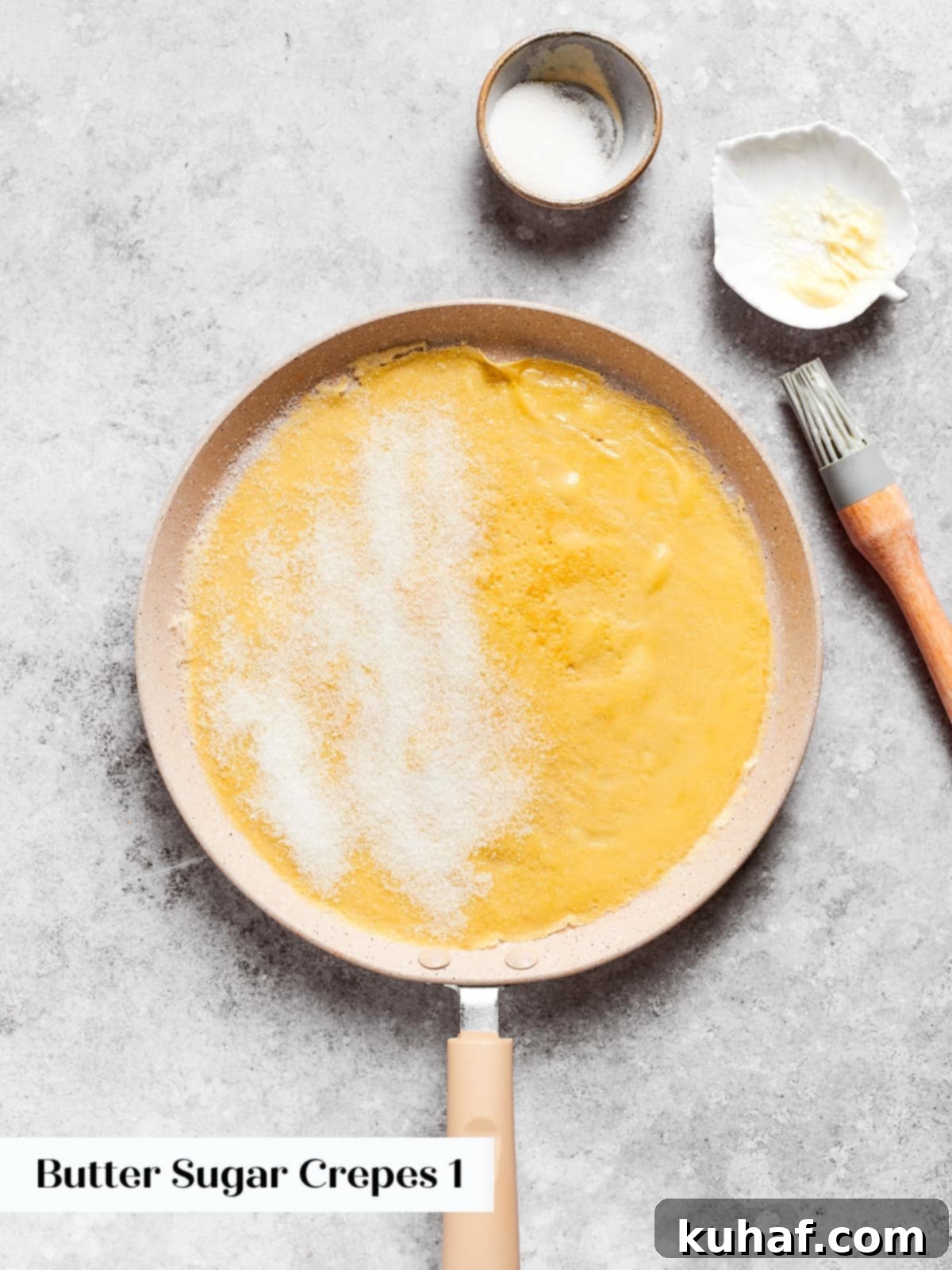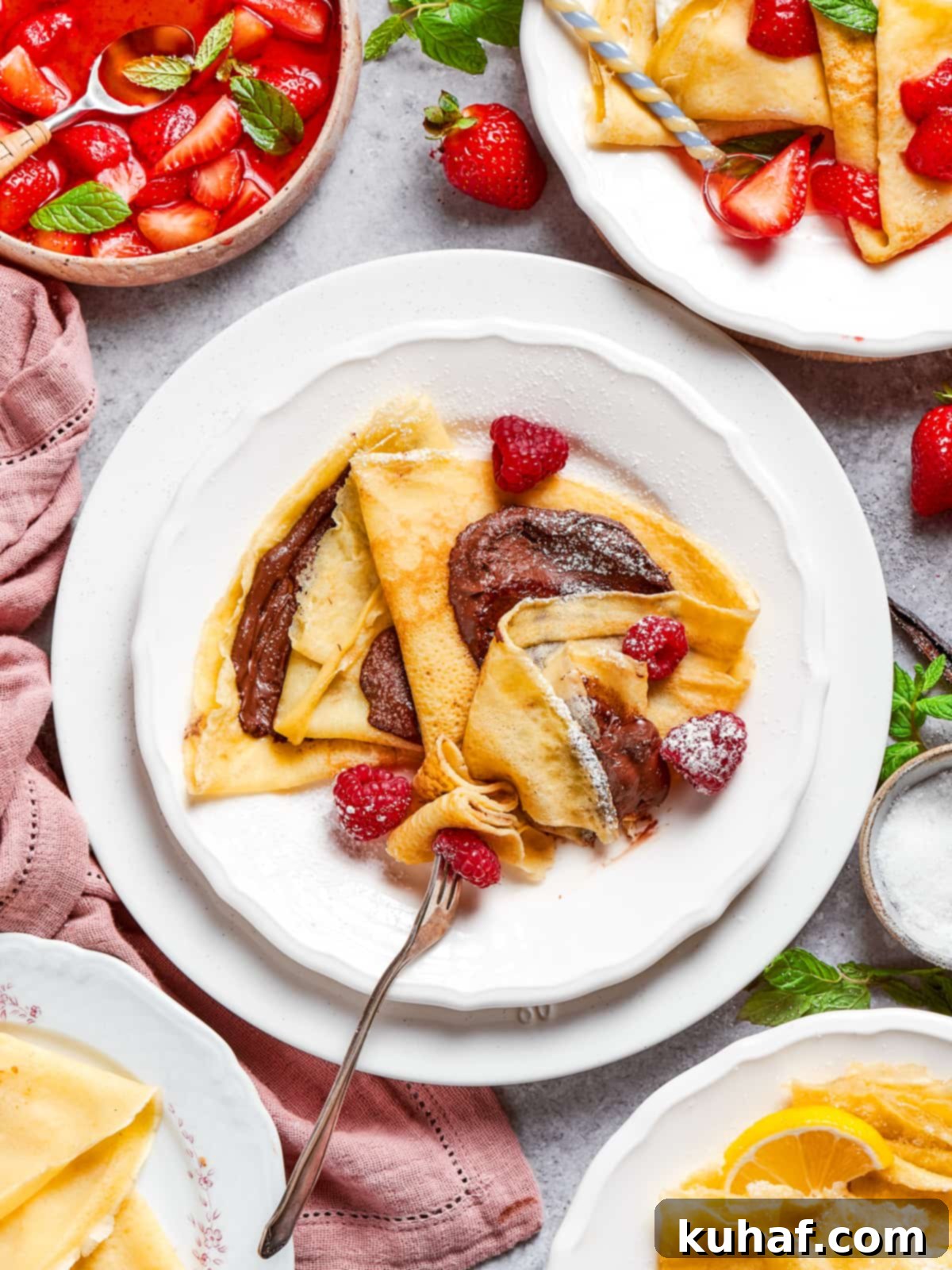Master the Art of Sweet Crêpes: Your Ultimate Guide to Thin, Buttery & Irresistible Homemade Delights
Unlock the secrets to crafting perfect, paper-thin, and exquisitely buttery sweet crêpes right in your own kitchen. This comprehensive guide provides you with a simple 6-ingredient crêpe recipe, complemented by all my professional tips for achieving those coveted crispy edges and a tender, delicate texture. Whether you’re dreaming of elegant dessert crêpes, a delightful breakfast, or assembling a show-stopping mille crêpe cake, this recipe is your foundation for culinary success.


A Quick Look At The Recipe
This is a brief summary of the recipe. Jump to the recipe to get the full details.
Jump to Recipe
Prep Time
10 minutes
Cook Time
8 minutes
Chill
1 hour
Total Time
1 hour 18 minutes
Servings
13 10-inch crepes
Difficulty
Moderate, needing patience with thin batter
Calories *
152 kcal per serving
Technique
Whisk wet ingredients, add flours and water, rest, cook til golden.
Flavor Profile
Thin, buttery crêpes with crisp edges and a soft, delicate texture.
* Based on nutrition panel
Summarize & Save this content on
Why You Will Love This Recipe
- Thin and buttery crêpes with perfect texture. This recipe employs a clever combination of both cake flour and all-purpose flour. This duo is essential for creating a crêpe that is incredibly delicate and light, yet robust enough to perfectly cradle any filling you desire. The result is a melt-in-your-mouth texture that is simply irresistible.
- An authentic taste of French classic at home. My journey through France, particularly my delightful encounters with street-side crêpes in Paris, deeply inspired this recipe. I’ve meticulously crafted these crêpes to capture that genuine French essence – from their delicate aroma to their satisfyingly crisp edges and tender centers. Bring the charm of a Parisian café right into your home!
- Endless possibilities for toppings and fillings. The beauty of homemade crêpes lies in their versatility. Setting up a “fill-your-own” crêpe station on a Sunday morning is a fantastic way to cater to every sweet tooth in the family. Imagine fresh berries, rich chocolate spreads, luscious whipped cream, sweet jams, or even savory options. The only limit is your imagination!
- Effortlessly freezer-friendly for future enjoyment. Planning a big brunch or simply want to have a quick, elegant treat on hand? These buttery soft crêpes are perfect for making in advance. You can prepare a large batch and freeze them, ready to be thawed and enjoyed whenever a craving strikes. It’s a fantastic way to get ahead, and your guests will never guess they weren’t made moments ago.
Table of Contents
- Why You Will Love This Recipe
- Ingredients & Substitutions
- Variations for Sweet Crêpe Fillings
- Professional Tips
- How to Make This Sweet Crêpe Recipe
- Chef Lindsey’s Recipe Tip
- Recipe FAQs
- Recommended Brunch Recipes
- Sweet Crepe Recipe Recipe
- Before You Go
Ever since my unforgettable trip to France, the memory of those exquisitely thin, perfectly buttered and sugared crêpes has lingered in my mind. For a long time, I’ve been on a mission to recreate their delicate crisp edges and wonderfully tender texture. After much experimentation and dedication, I am thrilled to share what I believe is the perfect sweet crêpe recipe, embodying that authentic French charm.
Crafting the perfect crêpe truly is a labor of love, but the immense satisfaction of biting into a homemade, delicate crêpe makes every moment worthwhile. However, I completely understand if you’re seeking a more straightforward yet equally impressive breakfast or brunch option. For those occasions, I heartily recommend these lazy Sunday buttermilk waffles or whole wheat pancakes. If you’re ready to elevate your baking game even further, you absolutely must try my phenomenal cinnamon roll recipe with cream cheese icing.
Key Ingredients & Smart Substitutions

This simple crêpe recipe relies on just a few basic ingredients. Understanding their role and knowing how to make smart substitutions will ensure perfect results every time.
- Whole Milk: Whole milk is crucial here because its higher fat content contributes significantly to the richness and tender texture of the crêpes. The fat helps to create a softer, more pliable crêpe. While whole milk is ideal, you can absolutely substitute it with any milk alternative you prefer, such as almond milk, soy milk, or oat milk, though the richness might vary slightly.
- Butter: Melted butter adds a wonderful depth of flavor and helps create those coveted crispy edges. It’s important that your melted butter is warm, but not piping hot, when you incorporate it into the batter. This prevents it from solidifying prematurely when it hits the colder milk and eggs, ensuring a smooth, lump-free batter. Unsalted butter is generally preferred for baking, giving you control over the salt content.
- All-purpose Flour: This flour provides the essential structure for your crêpes. All-purpose flour has the perfect amount of gluten to hold the thin batter together, preventing it from tearing, yet without making the crêpe tough or chewy.
- Cake Flour: The addition of cake flour is a professional secret for creating an incredibly light and delicate crêpe. Cake flour has a lower protein content than all-purpose flour, resulting in a tender crumb. If you don’t have cake flour, you can use all-purpose flour for the entire amount, but be extra careful not to overmix the batter. In this case, I highly recommend letting the batter sit overnight to allow the gluten to relax as much as possible, ensuring a tender outcome.
- Water: Water helps to thin the batter to the perfect consistency, which is vital for paper-thin crêpes. I use tap water in NYC, known for its high quality. If you know your local tap water is hard or heavily chlorinated, using bottled or distilled water can make a difference in the final taste and texture.
- Granulated Sugar & Vanilla Extract (Optional for Sweetness): While not explicitly listed as a primary ingredient in some basic crêpe recipes, a touch of granulated sugar in the batter enhances the sweetness, especially for dessert crêpes. A dash of vanilla extract also adds a beautiful aromatic depth. Feel free to adjust these to your taste for truly sweet crêpes.
See the recipe card below for full information on ingredients and precise quantities.
Delicious Variations for Sweet & Savory Crêpe Fillings
The beauty of crêpes lies in their incredible versatility! While this recipe focuses on sweet crêpes, a few simple additions or changes can transform them into a delightful savory meal or an even more decadent dessert. Get inspired with these filling ideas:
- Embrace Savory Crêpes. Don’t limit yourself to sweet! You can easily transition these crêpes to savory. Imagine filling them with thinly sliced ham and melted Gruyère cheese while still in the pan, folding them into a perfect square. For a brunch classic, make it lox-style by adding a smear of cream cheese, delicate smoked salmon, and finely diced red onions. You could even create a sophisticated filling with my easy caramelized onions, sautéed mushrooms, and crumbled blue cheese. For added protein, cottage cheese is a simple choice, or introduce a surprising dash of sweetness with a drizzle of maple syrup alongside savory ingredients.
- Zesty Lemon Crêpes. For a bright and tangy delight, fill cooled crêpes with my rich and creamy easy lemon curd. Take it a step further by pairing it with this light and airy lemon curd whipped cream recipe, then garnish with your favorite fresh berries or sliced kiwi for a burst of color and flavor.
- A Symphony of Jams and Creams. Layer in your favorite homemade or store-bought jams for a quick and satisfying treat. This easy strawberry jam recipe, mixed berry jam, or easy peach preserves recipe all work beautifully. To add an extra layer of creamy goodness and balance the sweetness of the jam, I highly recommend a dollop of homemade whipped cream or a spoonful of crème fraîche.
- Pie Filling Extravaganza! Why not transform your crêpes into individual “pie” pockets? Layer in some warm apple pie filling, vibrant cherry pie filling, or use the delicious filling from this blueberry pie recipe! Serve these warm crêpe pies with a generous scoop of vanilla bean ice cream for an ultimate dessert experience.
- Chocolate Lover’s Dream. Beyond Nutella, consider spreading a rich chocolate ganache, or even a simple sprinkle of chocolate chips that melt slightly as the crêpe warms. Add sliced bananas for a classic combination.
- Fresh Fruit & Yogurt. For a lighter, healthier option, spread a layer of Greek yogurt (plain or vanilla) and top with an assortment of fresh berries, sliced peaches, or mango. A drizzle of honey or maple syrup completes this fresh treat.

Professional Tips for Crêpe Perfection
Making truly exceptional crêpes is an art that benefits greatly from a few chef-tested techniques. Follow these professional tips to achieve consistently perfect, thin, and delicious crêpes every time.
- Embrace a Thin Batter for Thin Crêpes. Do not be alarmed by the liquidy consistency of this batter; it’s exactly what you want! Many home cooks fret, thinking they’ve mismeasured something, but remember: a very thin batter is absolutely essential for creating those delicate, paper-thin crêpes that are the hallmark of a true French classic. A thick batter will inevitably yield thick, pancake-like results, not the elegant crêpes you’re aiming for.
- The Golden Rule: Let the Batter Rest! This is perhaps the most critical step often overlooked. Allowing the batter to rest for at least an hour, or ideally overnight in the refrigerator, makes a world of difference. This resting period allows the flour to fully hydrate, resulting in a smoother batter and preventing lumps. Crucially, it also gives the gluten a chance to relax, which is key to avoiding rubbery crêpes and ensuring a tender, delicate texture. If refrigerating overnight, remember to let the batter sit at room temperature for about an hour before cooking. Cold butter in a cold batter will make it harder to spread evenly and thinly.
- Choose the Right Pan for Even Heat. The type of pan you use significantly impacts your crêpe success. Electric and induction burners, with their inherently even heat distribution, are more forgiving. However, if you’re using a gas burner, which concentrates heat at the center, a crêpe pan or nonstick skillet with a thick, heavy base is absolutely essential. This thick base absorbs and spreads the heat uniformly across the entire cooking surface, preventing hot spots and ensuring your crêpes cook evenly to a beautiful golden brown.
- One Buttering is Often Enough. You only need to lightly butter your pan before cooking the very first crêpe. This initial buttering is crucial to prevent that first crêpe from sticking. For all subsequent crêpes, the small amount of butter already present in the batter (which melts as it cooks) is usually sufficient to lightly grease the pan. If you find your crêpes starting to stick later on, a minimal re-buttering might be needed, but aim to keep it light.
- Patience is a Virtue: Crêpes Take Time. Making crêpes is not a race. Each crêpe typically takes about 6-8 minutes to cook thoroughly on both sides, especially on medium-low heat. The only way to significantly speed up the process is by using multiple crêpe pans simultaneously, which can be a financial and space commitment. Embrace the slow, deliberate process; it’s part of the charm and ensures each crêpe is cooked to perfection, much like waiting for a freshly made crêpe from a Parisian vendor—c’est normal.
- The “First Crêpe” Phenomenon: Don’t be discouraged if your first crêpe isn’t perfect. It’s often referred to as the “test crêpe” because it helps you gauge the pan’s temperature and the batter’s consistency. It might be too thick, too thin, or unevenly cooked. Adjust your heat or batter consistency slightly after this first attempt, and subsequent crêpes will be much better.
How to Make This Sweet Crêpe Recipe: A Step-by-Step Guide
Follow these detailed instructions to achieve consistently perfect, delicate French crêpes every time. Further details on precise measurements can be found in the recipe card below.
Step-by-Step: Preparing the Crêpe Batter
Step 1: Whisk the Wet Ingredients. In a spacious large mixing bowl, combine the eggs, a pinch of salt, the whole milk, and the melted butter. Whisk these ingredients together vigorously until they are thoroughly combined and smooth. This creates the essential liquid base for your crêpes.




Step 2: Incorporate Flours and Water. Gradually whisk in both the all-purpose flour and cake flour, adding a little at a time, similar to how you would prepare popovers. This slow addition helps prevent lumps and ensures a smooth batter. Once the flours are mostly incorporated, whisk in the water last until the batter is completely smooth and free of any visible lumps.
The batter will have a very liquid consistency. This is intentional! Remember, thick batter makes thick crêpes; we are aiming for delicate, thin ones.
Step 3: Allow the Batter to Rest. Once the batter is prepared, cover the bowl and let it sit. Ideally, refrigerate it overnight, or at the very least, allow it to rest for a minimum of one hour at room temperature. This resting period is crucial; it allows the flour to fully hydrate and any gluten that may have developed during mixing to relax. A well-rested batter results in much more tender and pliable crêpes.
Step-by-Step: Cooking Your Perfect Crêpes
If your batter has been refrigerated, remove it from the fridge about an hour before you plan to start cooking. This allows the butter to soften and the batter to come to room temperature, which helps in spreading it thinly.
Step 4: Preheat Your Pan Slowly. Place a crêpe pan or a high-quality nonstick skillet over medium heat. The key here is “slow and steady wins the race.” Allow the pan to preheat thoroughly and evenly, ensuring a consistent cooking temperature. This can take a few minutes.
Step 5: Butter the Pan (Just Once!). For the very first crêpe, lightly butter the pan. A neat trick is to stab a small piece of butter with a fork and quickly rub it over the entire surface of the hot pan. You’ll generally only need to do this for the first crêpe, as the butter in the batter will naturally grease the pan for subsequent ones. You can use a small amount of vegetable oil if you prefer, but butter imparts a superior flavor.
Step 6: Pour and Swirl a Thin Layer. With one hand, pour approximately one ladleful (just shy of 4 ounces) of batter directly into the center of the preheated pan. Immediately, use your other hand to quickly swirl the pan in a circular motion. This distributes the thin batter evenly across the entire bottom surface, creating a perfectly round and thin crêpe.
I’ve found that a crêpe spreader can be a tricky tool to master and is often unnecessary. Swirling the pan is usually more effective for achieving even thinness, especially for beginners. Using a spreader requires very precise temperature control; if the pan is slightly too hot, the batter sets before you can spread it, but if it’s too cool, it just slides around. Over-fussing can also cause the batter to stick to the spreader itself.
Step 7: Cook the First Side Until Golden. Allow the crêpe to cook over medium-low heat. Watch patiently as the edges begin to brown and subtle browner spots start to show through near the center of the crêpe. The outer edge is an excellent indicator of readiness. For a 12-inch crêpe, this typically takes about 6 minutes, but timing can vary with pan and heat.
Step 8: The Gentle Flip. Once the first side is beautifully golden, carefully slide a thin spatula underneath the center of the crêpe and gently flip it over, much like you would a pancake. Don’t worry if it folds slightly; simply unfold it with your spatula. If you flip it too early and it appears too pale, just flip it back and continue cooking for a little longer. Don’t stress, practice makes perfect!
Step 9: Continue Cooking the Second Side. After flipping, allow the crêpe to cook for an additional 1-2 minutes on the second side. This side generally cooks faster than the first. You’re looking for a light golden color and a cooked-through texture.
It might feel like it takes an eternity, but as anyone who has patiently waited for a freshly made crêpe in Paris knows, c’est normal (it’s normal). This patience is rewarded with superior taste and texture.
Step 10: Cool or Serve Immediately. Once cooked, carefully remove the crêpe from the pan. You can transfer it to a wire rack to cool completely if you plan to stack them or add cold fillings. Alternatively, if serving warm, proceed directly to adding your desired toppings.
Step 11: Repeat and Stack. Continue this process with the remaining batter. Once the crêpes cool completely, you can stack them without fear of them sticking together.
To Assemble & Plate Your Perfect Sweet Crêpes:




To prepare classic Butter Sugar Crêpes: For this authentic French treat, you’ll want to assemble them hot, directly in the pan. After you’ve flipped the crêpe, gently rub a small pat of butter (the same type you used for buttering the pan initially) over half of its surface. Then, sprinkle a delicate dusting of granulated sugar over the buttered half. Fold the crêpe neatly in half, then continue to cook for an additional minute or two, allowing the sugar to caramelize slightly and the butter to infuse. Fold it in half once more to create a charming triangle, then serve immediately while hot. A squeeze of fresh lemon juice or a drizzle of maple syrup can elevate this simple pleasure.
To prepare decadent Nutella Crêpes: These can be enjoyed fresh from the pan or assembled later. Simply spread a generous layer of Nutella or your favorite chocolate hazelnut spread over half of the crêpe. Fold it neatly in half, and then fold it in half again, creating a convenient triangle pocket. For an extra touch, add sliced bananas or strawberries before folding.
To prepare fresh Berries and Cream Crêpes: For this delightful combination, allow your crêpes to cool completely before assembling; otherwise, your delicate cream will melt. While the crêpe batter is resting, prepare your berry filling: toss 2 cups of chopped strawberries and any other desired mixed berries with about ¼ cup of granulated sugar and a squeeze of fresh lemon juice. Stir gently and cover, allowing the berries to macerate and release their juices. This step can be done up to 3 days in advance. For the cream, whisk together cold heavy cream, a little powdered sugar (to taste), and vanilla extract until soft peaks form. For a beautiful visual effect and intensified flavor, consider adding vanilla bean paste. If you prefer to serve these crêpes warm, I highly recommend using a scoop of premium vanilla bean ice cream instead of whipped cream, as it will hold its shape better with the warmth.
Chef Lindsey’s Recipe Tip: The Virtue of Patience
Patience is truly the most crucial ingredient when it comes to making perfect crêpes. You simply *must* let the batter rest for AT LEAST an hour before cooking – ideally overnight. This allows the flours to fully hydrate and the gluten to relax, which is essential for a tender, non-rubbery crêpe. Furthermore, maintain a consistent medium-low heat on your pan. Rushing the cooking process by cranking up the heat will result in burned exteriors and undercooked, rubbery centers. Each crêpe will require approximately 6-8 minutes to cook beautifully. Don’t skip any steps, and don’t rush the process, or you risk ending up with tough, unevenly cooked, or even burned crêpes instead of delicate, golden perfections.
Sweet Crêpe Recipe FAQs
Proper storage ensures your crêpes remain delicious for days. As long as they have cooled completely before stacking, there is no need to separate each crêpe with a piece of parchment paper or wax paper. Simply stack them, wrap them well in plastic wrap to prevent air exposure, and refrigerate overnight. For longer storage, freeze them for up to a month in a freezer-safe bag or an airtight container. They thaw beautifully and maintain their delicate texture.
While I highly recommend a dedicated crêpe pan for its shallow sides and even heat distribution (this crepe pan is my favorite!), you can absolutely make delicious crêpes with a good quality nonstick skillet. The key is to ensure your nonstick skillet doesn’t have any scratches in its lining, as this can cause the crêpes to stick. A heavy-bottomed skillet also works best for even heat.
Lumps can be frustrating, but they’re fixable! The best way to achieve a silky-smooth batter is to prevent lumps in the first place by sifting your flours before adding them and whisking them in slowly. If, despite your best efforts, your batter is still lumpy, simply strain it through a fine-mesh sieve. This will catch any stubborn lumps and leave you with a perfectly smooth consistency.
Rubbery crêpes are typically the result of one of two common mistakes: overmixing the batter or not allowing it to rest for a sufficient amount of time (at least an hour). Overmixing develops the gluten too much, leading to a tough texture. Resting the batter allows the gluten to relax, which is essential for producing the soft, delicate, and pliable crêpes we all love. Additionally, cooking on too high heat can also contribute to a rubbery texture.
If your crêpes are consistently sticking, several factors could be at play. The most common reasons are that your pan isn’t hot enough when you pour the batter, or you didn’t adequately butter the pan for the first crêpe. A pan with a scratched or worn nonstick coating will also cause sticking. Ensure your pan is clean, properly preheated, and lightly greased for optimal results.
Absolutely, and it’s highly recommended! Preparing the crêpe batter ahead of time, even a day in advance, actually improves the texture and flavor. The overnight rest allows the flour to fully hydrate and the gluten to relax completely, resulting in incredibly tender and flavorful crêpes. Just remember to give it a quick whisk before cooking and let it come to room temperature if it was refrigerated.

More Delicious Brunch Recipes You’ll Love
Donut Recipes
Glazed Chocolate Donuts
Easy Bake Sale Ideas
Cinnamon Flop
Easy Breakfast Recipes
Pumpkin French Toast
Date Night
Buttermilk Biscuits
If you tried this recipe and loved it, please leave a 🌟 star rating and let me know how it goes in the comments below. I love hearing from you; your comments make my day!

Sweet Crêpe Recipe
Pin Recipe
Comment
Print Recipe
Ingredients
For the crepe batter
- 1 ½ cups whole milk
- 4 large eggs
- ½ teaspoon kosher salt
- 6 tablespoons butter melted
- 1 ½ cups all-purpose flour
- ½ cup cake flour
- 1 cup water
- 2 tablespoons granulated sugar (optional, for sweeter crepes)
- 1 teaspoon vanilla extract (optional)
For optional toppings
- unsalted butter
- granulated sugar
- strawberries
- raspberries
- whipped cream
- Nutella or another chocolate spread
- Lemon juice (for berries)
Instructions
Prepare the crêpe batter:
-
In a large mixing bowl, whisk together the eggs, salt, milk, melted butter, and optional granulated sugar and vanilla extract until well combined and smooth.
-
Slowly whisk in the all-purpose flour and cake flour, adding a little at a time to prevent lumps. Once the flours are mostly incorporated, whisk in the water last until the batter is completely smooth and liquidy.
-
Cover the batter and let it sit. Refrigerate overnight for best results, or allow it to rest for at least an hour at room temperature. This allows the flour to hydrate properly and any gluten to relax, ensuring tender crêpes.
How to cook crêpes:
-
If your batter was refrigerated, remove it from the fridge about an hour before you plan to start cooking to bring it to room temperature. Preheat a crêpe pan or nonstick skillet over medium heat. Allow it to heat slowly and steadily.
-
Using a fork, stab a small piece of butter and quickly butter the pan’s surface. You only need to do this for the first crêpe to prevent sticking.
-
Pour approximately one ladleful (just shy of 4 ounces) of batter into the center of the pan with one hand. Immediately, use your other hand to quickly swirl the pan in a circular motion, distributing the batter evenly and thinly across the entire surface.
-
Cook over medium-low heat on the first side until the edges begin to brown and you can see subtle golden-brown spots appearing near the center. The outer edge serves as an excellent indicator of readiness. For a 12-inch crêpe, this typically takes about 6 minutes.
-
Flip the crêpe by carefully sliding a thin spatula underneath its center and gently turning it over like a pancake. If it folds, simply unfold it with the spatula. If it’s too pale when flipped, gently flip it back. Don’t stress about imperfections.
-
Continue to cook the crêpe on the second side for an additional 1-2 minutes until lightly golden.
-
Remove the cooked crêpe from the pan and transfer it to a wire rack to cool, or add your desired toppings and serve warm immediately.
-
Repeat the cooking process with the remaining batter. Once completely cooled, stack the crêpes without them sticking together.
To assemble & plate sweet crêpes:
-
To prepare butter sugar crêpes: These are best prepared hot in the pan. After flipping the crêpe, gently rub a small pat of butter (the same one you put on the fork before the first crêpe) over half of its surface. Sprinkle that half with a delicate dusting of granulated sugar. Fold the crêpe in half, and continue to cook for an additional minute or two, allowing the sugar to melt and caramelize. Fold in half once more to form a triangle and serve hot. A drizzle of maple syrup or a squeeze of fresh lemon juice is also a delicious addition.
-
To prepare Nutella crêpes: You can serve these fresh from the pan or assemble them later. Spread half the crêpe generously with Nutella or another chocolate hazelnut spread. Fold it in half, and then fold it in half again, creating a convenient triangle. Add sliced bananas or strawberries for extra flavor.
-
To prepare berries and cream crêpes: Ensure these crêpes are completely cooled before assembling, or your cream will melt. When preparing your crêpe batter, you can macerate 2 cups of chopped strawberries and other fresh fruit with about ¼ cup granulated sugar and a squeeze of lemon juice. Stir and cover until you are ready to serve (this can be done up to 3 days in advance). For the cream, whisk together cold heavy cream, a little powdered sugar (to taste), and vanilla extract until soft peaks form. You can add vanilla bean paste for visual appeal and enhanced flavor. If you prefer to serve these crêpes hot, I suggest using a scoop of vanilla bean ice cream instead of whipped cream for a delightful contrast.
Notes
Presentation – Crêpe timing is an art. If the first side appears too pale, simply cook the second side a little longer to achieve a beautiful golden hue.
Technique – A specialized crêpe flipper is ideal as it’s designed to prevent tearing the delicate crêpes and won’t damage your nonstick pan. An offset spatula also works well as an alternative.
Storage – Allow crêpes to cool completely, then stack them. Wrap the stack tightly in plastic wrap and refrigerate for up to 3 days, or freeze for up to a month in an airtight container or freezer-safe bag.
Nutrition
Before You Go
I sincerely hope you enjoyed mastering this French crêpe recipe and that it brings a taste of Parisian delight to your home. Don’t stop here! Be sure to explore our other delicious breakfast recipes, perfect for any morning, from these comforting sourdough cinnamon rolls to our wholesome and flavorful blueberry banana bran muffins!
